4.4 - Water Pollution (ESS)
1/54
There's no tags or description
Looks like no tags are added yet.
Name | Mastery | Learn | Test | Matching | Spaced |
|---|
No study sessions yet.
55 Terms
Organic Pollution
Sewage is a common form of organic pollution but it could also be animal slurry or worse. This affects the water quality and biological indicators will correlate with distance from the source of pollution. This can result in particles floating in the water, reducing light penetration into the water. This is an increase in turbidity and can reduce the productivity of the water body as there is a reduction in light for photosynthesis.
Agricultural Run off
This can be in the form of eroded soil or excess agricultural effluent placed on the fields before raining. This can result in high levels of nitrates and phosphates in water bodies and thus nutrient enrichment of the water and the water can become eutrophic. This can also increase turbidity. Run-off from agricultural land may also contain pesticides and herbicides which enter water bodies and affect their biodiversity.
Industrial Effluent
Industrial effluent is an umbrella term for pollution from industrial sources and can include many different chemicals, depending on the source. It may include toxic metals or persistent organic pollutants (POPs), both of which bioaccumulate and biomagnify in food chains.
Urban Run off
This is another umbrella term for pollution from paved surfaces in urban areas. It may contain oil, plastics, microplastics and rubber from vehicle tyres. It will also contain air pollution particles that have been washed out of the atmosphere. It can also include the run-off from urban green spaces which may include pesticides and herbicides, soil and pet waste.
Solid Waste Disposal
Paper, cardboard, fast-food containers, packaging, plastics etc. can all end up in water bodies via storm drain runoff or direct tipping. Some will biodegrade but others may contain coverings that contain POPs that enter the water, and plastics simply degrade into smaller pieces, eventually becoming microplastics.
Oil spills
Famous oil spills tend to be more highly publicised (as was demonstrated in the nice cartoon in the November 2014 paper) such as Exon Valdez or Deepwater Horizon but as much, if not more, oil has been spilled in the Gulf Wars and the West African oil fields. Oil will directly coat animals and make it impossible for them to move but it may also be consumed and be toxic. The chemicals used to disperse oil spills can also be highly toxic.
Baltic sea eutrophication
The Baltic Sea is heavily affected by eutrophication, primarily due to agricultural runoff rich in nitrogen and phosphorus from countries like Poland and Sweden. This nutrient overload causes massive algal blooms, leading to oxygen-depleted "dead zones" where marine life cannot survive. Management strategies include HELCOM’s Baltic Sea Action Plan, which promotes nutrient reduction through better agricultural practices and wastewater treatment.
Deepwater Horizon - Oil Spill
In 2010, the Deepwater Horizon offshore drilling rig exploded in the Gulf of Mexico, releasing over 4 million barrels of oil into the ocean over 87 days. The spill caused extensive damage to marine ecosystems, killing wildlife and contaminating coastal habitats across several U.S. states. Cleanup efforts included chemical dispersants, controlled burns, and legal action, with BP paying billions in fines to support long-term environmental recovery.
Fundao Dam Collapse - Industrial Effluent
In 2015, the Fundão tailings dam near Mariana, Brazil, collapsed, releasing over 40 million cubic meters of mining waste into the Rio Doce. This industrial effluent destroyed aquatic ecosystems, contaminated drinking water, and displaced thousands of people. Response efforts include fines, lawsuits against mining companies (Samarco, Vale, and BHP), and ongoing restoration projects under the Renova Foundation.
Pasig River - Plastic Pollution
The Pasig River in the Philippines is one of the world’s most polluted rivers, primarily due to plastic waste from urban runoff, informal settlements, and industry. It transports an estimated 63,000 tonnes of plastic annually into Manila Bay, severely impacting aquatic life and human health. Cleanup strategies include the Pasig River Rehabilitation Commission, public awareness campaigns, and partnerships with NGOs to promote waste reduction and river restoration.
River Wye - Agricultural Runoff
The River Wye, spanning Wales and England, has suffered from severe water pollution linked to phosphate-rich runofffrom intensive chicken farming. This has triggered excessive algae growth, harming fish populations and degrading the river’s biodiversity. Environmental groups are urging stricter regulations on manure management, while local authorities and farmers are exploring buffer zones and sustainable feed practices.
Sewage Pollution in the UK - Organic Pollution
In the UK, untreated sewage discharges into rivers and coastal waters have become a major issue, particularly after heavy rainfall overwhelms outdated sewer systems. This organic pollution depletes oxygen levels and introduces pathogens, threatening ecosystems and public health. Campaigns by groups like Surfers Against Sewage have pressured the government and water companies to invest in infrastructure upgrades and enforce stricter penalties.
Endocrine disrupting chemicals
Natural or human-made chemicals which can mimic, block or interfere with an organism’s hormones (hormones are chemicals that coordinate different functions in the body, e.g. thyroxine controls your metabolic rate).
Tributyltin
A compound used as a biocide in antifouling paints, as a stabilizer in plastics, and in disinfectants against fungal attacks and is also found in industrial water. It is extremely toxic to aquatic life. It was banned in marine paints in 2003 by the International Maritime Organisation and in the EU in 2008. It disrupts reproductive function and lipid metabolism and is responsible for reproductive failure in molluscs.
PCBs
Polychlorinated Biphenyls and are fat-soluble, therefore likely to accumulate and biomagnify in food chains. They are persistent organic pollutants and were banned in the USA in 1979.
Heat Energy - pollutant
As the temperature of water rises, less oxygen is able to be dissolved in the water. Water is used in thermal power plants to generate steam that turn turbines. This includes oil, gas, coal, and nuclear power plants. some solar power plants use steam. The water is then passed through a cooling tower before re-entering a nearby river where the water originated from. The water is always warmer than it was originally and can change the local ecosystem.
Biological pollutants
Invasive species, light, noise, pathogens, and radioactive pollution.
Ocean Gyres - plastic pollution
The ocean clean-up finds that 75% - 86% of plastic in the great Pacific garbage patch originates from offshore fishing and aquaculture activities. Once plastic enters the environment, ultraviolet light starts to degrade the plastic and it becomes microplastic in the oceans. Most plastic enters the oceans from rivers and then the ocean currents mean that this accumulates in the big circulating currents called gyres. Larger pieces of plastic can damage wildlife causing starvation and drowning. The microplastics from degraded plastic can accumulate and then magnify in the food chain but they also are very "sticky" and trap and transport surface toxins. These have been found in humans in the fatty plaques that form in blood vessels.
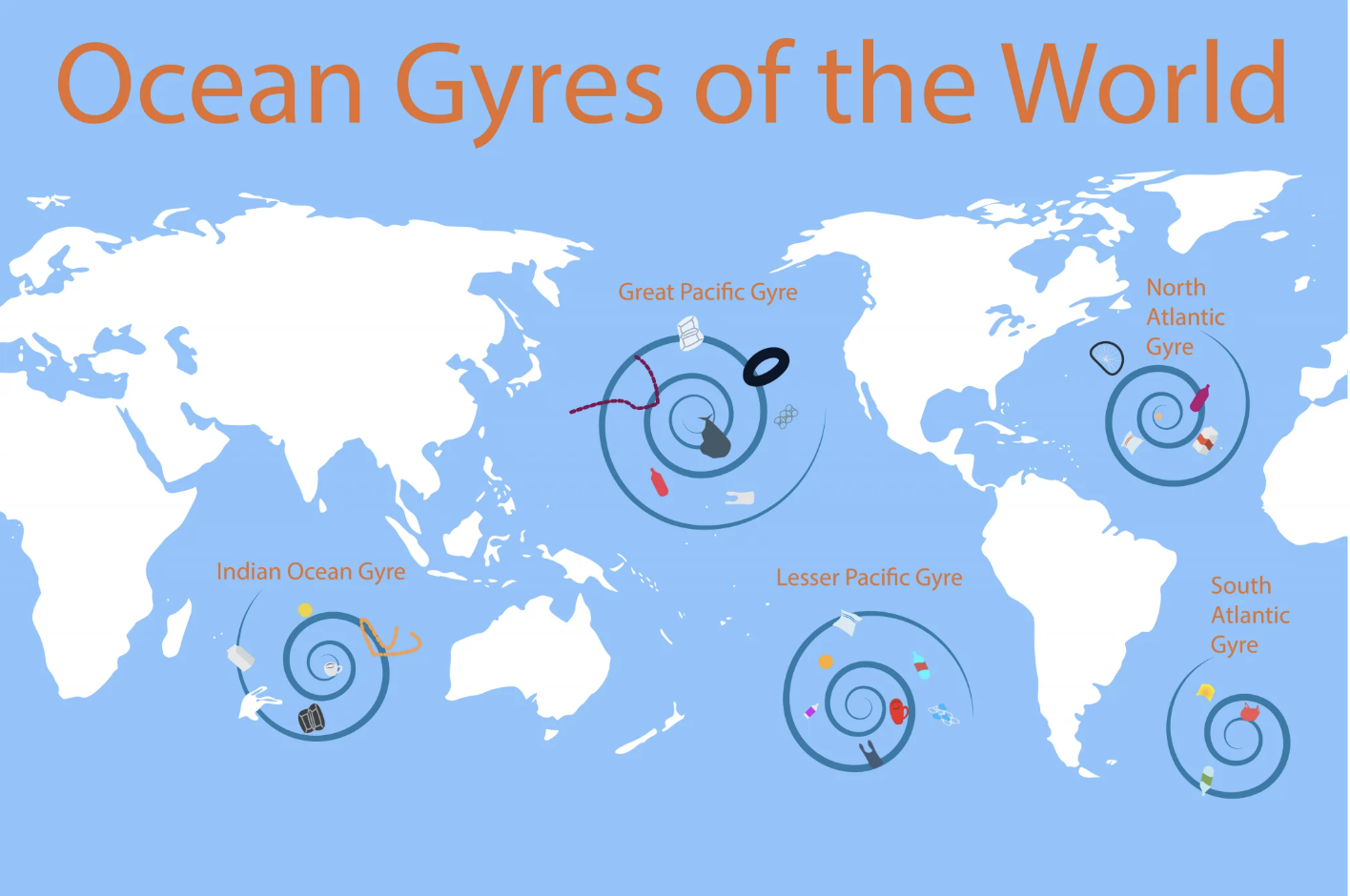
UNEP - on plastic pollution in water
According to UNEP, every year 19-23 million tonnes of plastic waste enters aquatic ecosystems from the 430 million tonnes produced every year. The UN agreed to end plastic pollution and agree on a legally binding agreement by the end of 2024. UNEP has a good interactive visual story about plastic which is available in multiple languages.
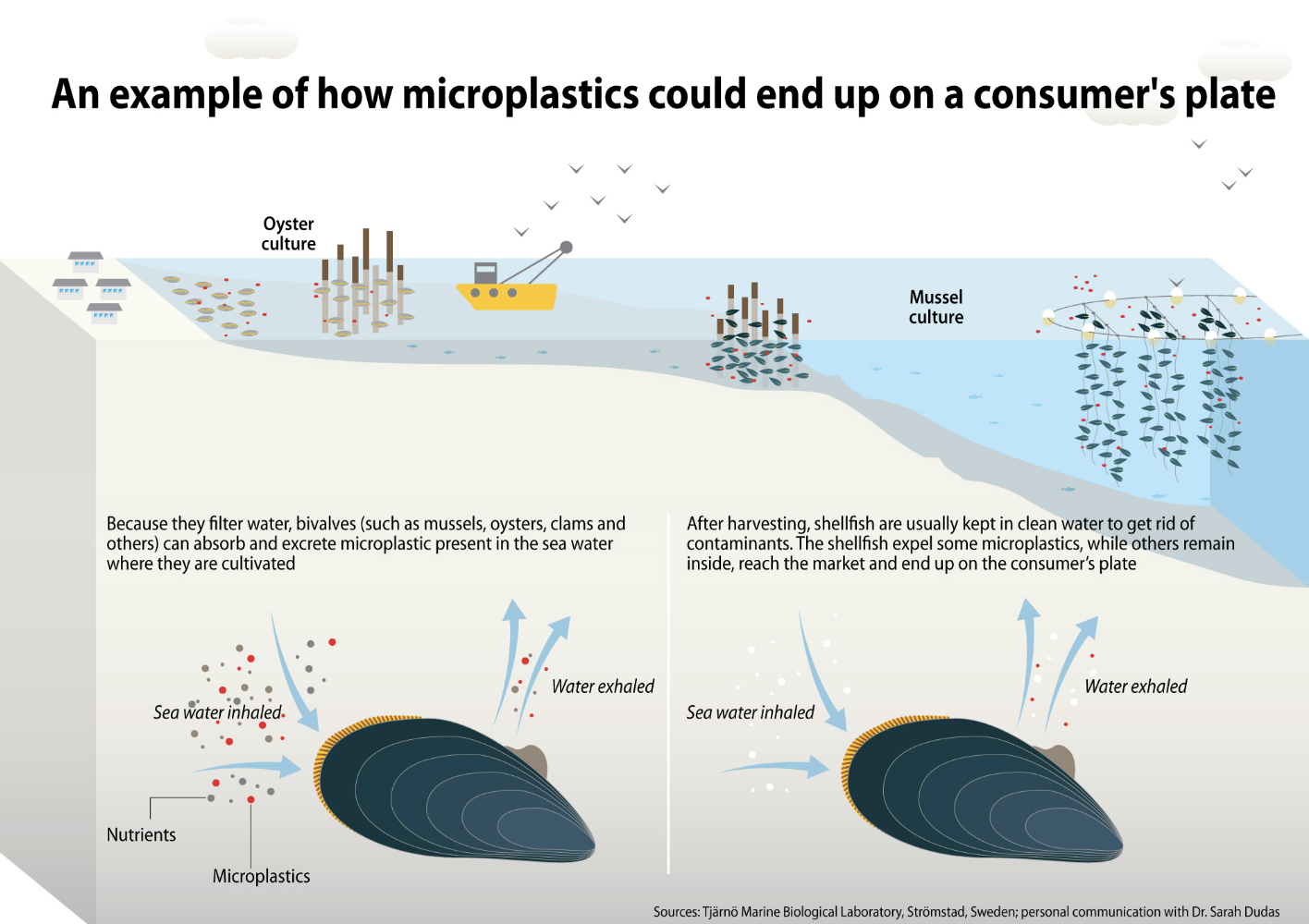
UN negotiation on plastic pollution
The United Nations is currently negotiating a global treaty on plastic pollution, aiming for a legally binding agreement by 2025 that addresses the full life cycle of plastics, including production, design, and waste management. From an economic perspective, a circular approach could reduce plastic pollution by promoting reuse, recycling, and product redesign, creating economic incentives for sustainable materials and reducing the costs of environmental damage. Ethically, virtue ethics would emphasize responsible consumer and corporate behavior, consequentialist ethics would focus on minimizing harm to ecosystems and future generations, and rights-based ethics would highlight the right of all people to live in a clean and healthy environment. Together, these frameworks support the shift toward a just and sustainable global response to the plastic crisis.
Water Quality
The measurement of chemical, physical, and biological characteristics of water and is often measured using a water quality index (WQI). These include dissolved oxygen (DO), pH, temperature, turbidity, specific metals, total suspended solids and concentrations of nitrates and phosphates. Water treatment plants check the quality of water exiting the plant but environmental officers also check the water quality in streams, rivers, lakes and coastal locations.
How does checking water quality help?
It allows authorities to be alerted to any problems with water, to alert the public and to start management strategies that will counteract the problems. It would also alert the plant to ensure the water was recirculated in the plant, rather than being allowed to enter the river.
Biochemical oxygen demand (BOD)
A measure of the amount of dissolved oxygen required by microorganisms to decompose organic material in water. The usual measure is milligrams of oxygen consumed per litre of sample in five days at 20°C. BOD provides an indirect measure of the amount of organic matter within a sample. The greater the amount of organic pollution (sewage / organic matter) the more oxygen-consuming microbes are required to break it down and therefore the greater the BOD. Another indirect measure is using indicator species for pollution in aquatic ecosystems. Measuring dissolved oxygen in water is a direct measure of the water quality.
Eutrophication
Occurs when lakes, estuaries and coastal waters receive inputs of mineral nutrients, especially nitrates and phosphates, often causing excessive growth of phytoplankton. Algal blooms only occur if phytoplankton growth had previously been limited by lower concentrations of phosphate and/or nitrate. Humans cause eutrophication when releasing detergents, sewage or agricultural fertilizers into water bodies. Eutrophication leads to a sequence of impacts and changes to the aquatic system. Excessive growth of phytoplankton is typically followed by their death and, therefore, high rates of decomposition, rapid consumption of dissolved oxygen leading to hypoxia or anoxia in the water, and death of aquatic life that depends on dissolved oxygen. This is a positive feedback loop.
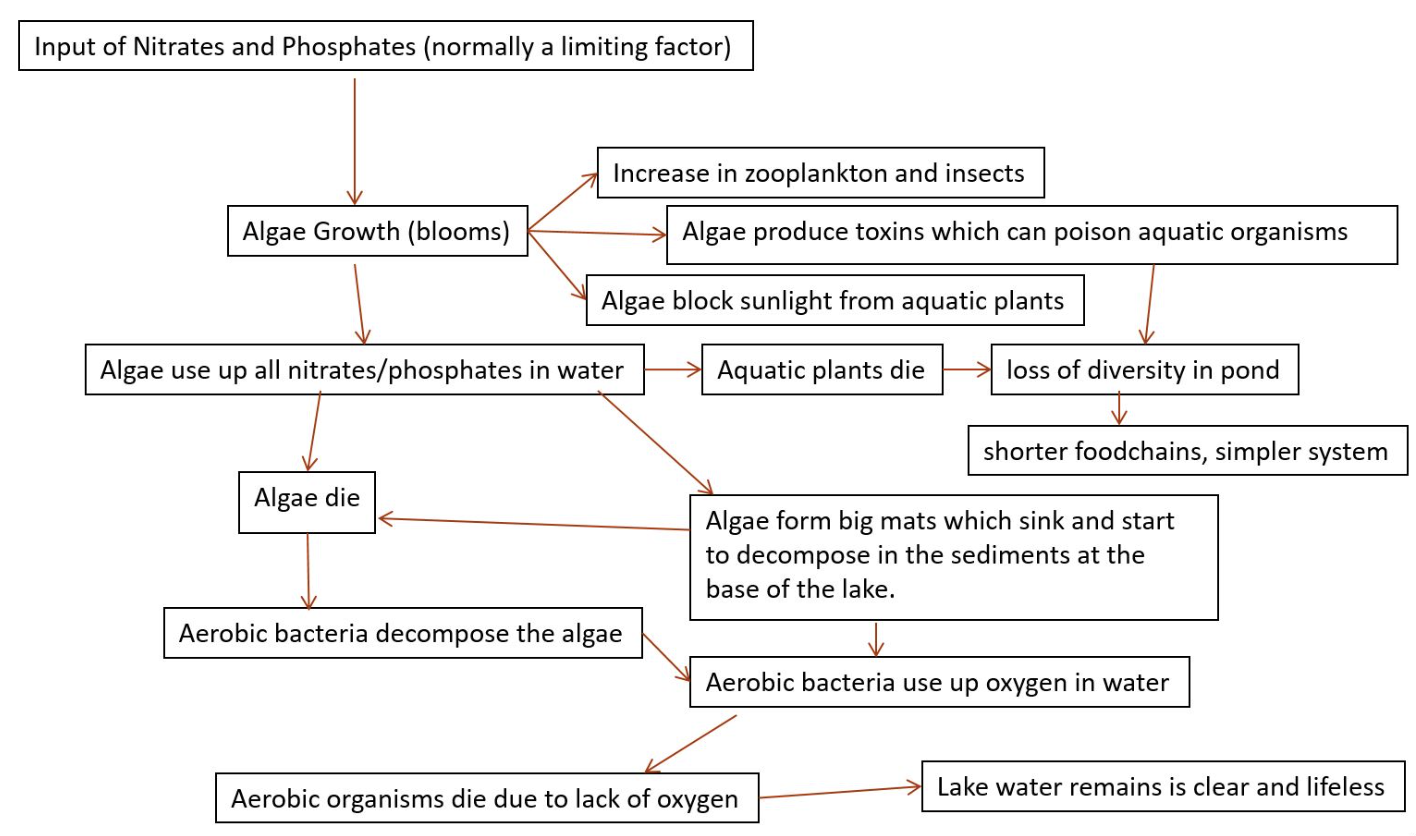
Further impact of eutrophication.
If dead zones develop, fishing productivity declines and there may be associated harmful algal blooms that produce potentially fatal toxins and prevent water being used for recreation or shellfish from being consumed. Eutrophic areas are not aesthetically pleasing, with the water becoming green and stagnant. Dead fish may even be washed up on the shorelines.
Reduction of human activities that produce pollutants - management of eutrophication.
Alternatives to current fertilizers and detergents. These solutions may increase the costs (e.g. detergents may require a financial commitment). Alternative products may still cause other environmental problems. May require time for replacements to be found but does force companies into this option.
Reduction of the release of pollution into the environment - eutrophication management
Treatment of wastewater to remove nitrates and phosphates. Buffer zones can be introduced to reduce the release of agricultural run-off. Wastewater treatment is expensive though not complex. It is a very commonly implemented solution. Using nature-based solutions, such as reed beds can increase biodiversity and decrease costs though they still need to be maintained. Buffer zones increase biodiversity but take some land out of agricultural production.
Removal of pollutants from the environment and restoration of ecosystems - Eutrophication management
Removal of mud from eutrophic lakes. Reintroduction of plant and fish species. Reverse osmosis can be used to remove pollutants. Dredging excess algae and water plants. These are only long-term solutions if the source of the pollution is removed. Oxygen can be pumped into eutrophic bodies of water to help organisms survive.
Algal Blooms
may produce toxins that threaten the health of humans and other animals. Harmful algal blooms (HABs) contain a variety of organisms, including cyanobacteria, protists, algae and dinoflagellates. A small number of these organisms produce potentially fatal toxins. In freshwater, cyanotoxins are the most common toxins. Within the HABs that occur along coastlines, dinoflagellates produce different toxins, including a neurotoxin; these may be red.
HABs real example
Harmful algal blooms (HABs) in freshwater are exemplified by blooms of cyanobacteria (blue-green algae) in Lake Erie, USA, largely caused by agricultural runoff rich in phosphorus. These blooms produce toxins that contaminate drinking water and harm aquatic life. In marine environments, HABs such as red tides caused by Karenia brevis in the Gulf of Mexico release neurotoxins that lead to massive fish kills and respiratory issues in humans. Both cases are worsened by nutrient pollution and climate change, highlighting the need for better watershed management and pollution control.
Anoxic / hypoxic waters
The frequency of anoxic/hypoxic waters (low dissolved oxygen levels) is likely to increase due to the combined effects of global warming, freshwater stratification, sewage disposal and eutrophication. Hypoxic conditions can arise from a variety of causes, resulting in aquatic dead zones.
Pre-treatment of sewege
This involved a grid or grill which removes items that shouldn't be going through the treatment process. Sometimes sewers also serve storm drainage and this means that rubbish from the streets can end up at the sewage treatment plant and sometimes people put things into the toilet that they shouldn't! These items are removed and go to landfill or incineration. Fat and grease are also removed at this stage by skimming it off the surface.
Primary treatment
During this process, the solids in the water are allowed to sediment or settle down to the bottom of tanks. The liquid is directed onto the next stage and the sludge is scraped off for sludge treatment. This can involve biogas generators that produce biogas from the sludge. The residue is then sent to landfill, incineration or for agricultural use in some countries.
Secondary treatment
There are two parts to secondary treatment but both utilise the power of microorganisms (bacteria) to remove organic matter from the water. Anaerobic bacteria followed by aerobic bacteria (air is pumped into these tanks) remove organic matter, nitrates and phosphates. The water is passed through these tanks several times to ensure all organic matter is removed.
Tertiary Treatment
The water may be passed through activated charcoal to remove any final pollutants or ozone is passed through the water. This acts like a sterilisation process.
Fourth stage
To remove micro-pollution like pharmaceutical residues, the water can be passed through activated carbon filters. This last stage can cost a lot but can be mandated by the government as an environmental incentive. At this stage, the water quality is checked, particularly for bacteria, before it is released into the environment.
Sewage treatment
The whole process is very expensive and requires a lot of investment to install such a water treatment plant and the infrastructure that collects and transports the sewage. This is a very big challenge for low-income countries. SDG 6 is focused on clean water and sanitation.
Climate change on water treatment
As climate change is increasing the intensity of rainfall, this is causing problems for the capacity of installations and holding tanks are having to be installed to increase capacity. If this is exceeded, only the pre-treatment and possibly the primary treatment may be utilised.
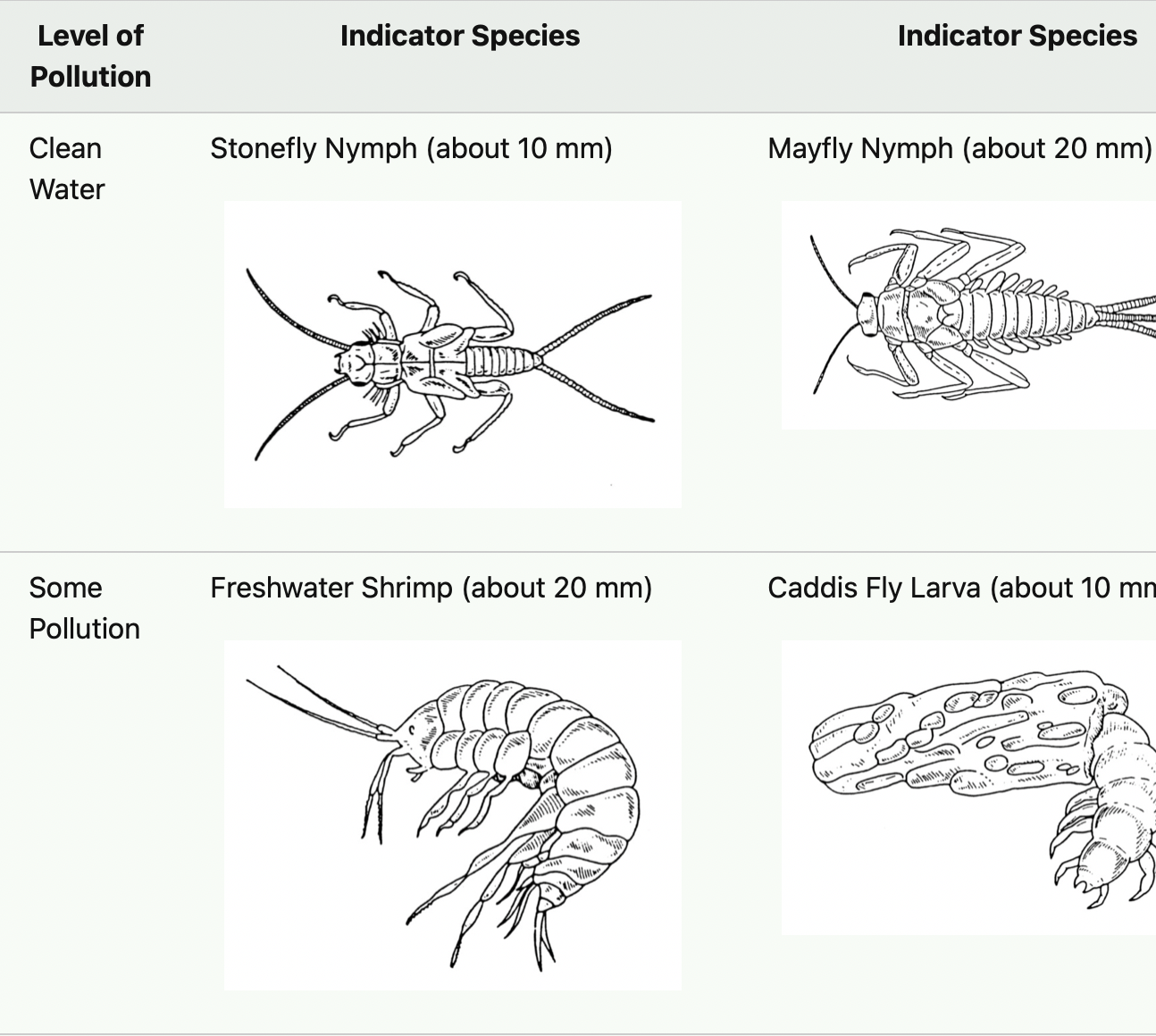
Indicator species
The species that are sensitive to pollutants or adapted to polluted waters. They can be used to indicate the pollution level of water bodies.
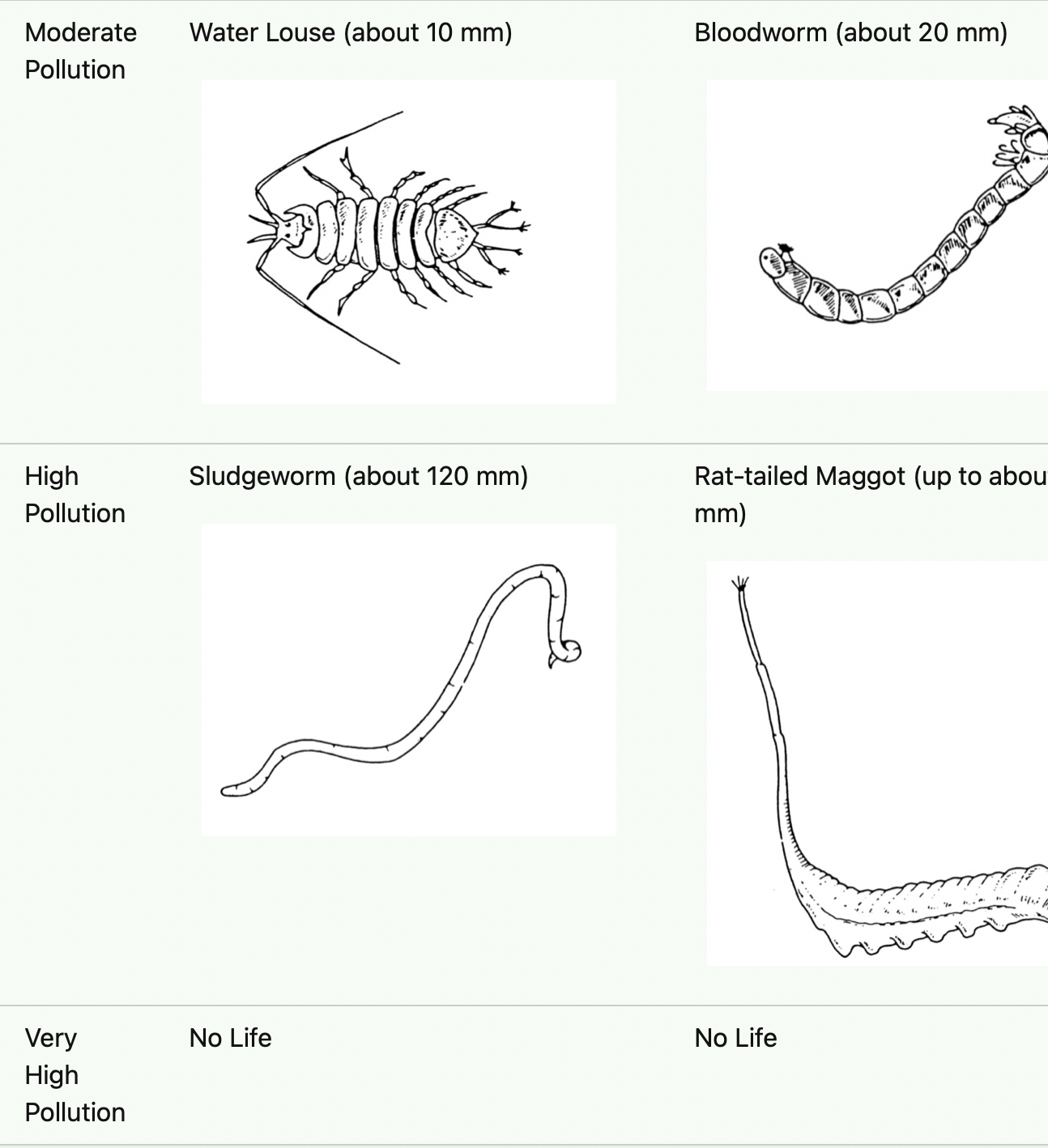
Example - tolerant indicator species
Tubifex worms are a tolerant indicator species, often found in heavily polluted or low-oxygen freshwater environments, signaling poor water quality.
Example - Intolerant indicator species
The mayfly nymphs are an intolerant indicator species, only thriving in clean, well-oxygenated water, making them a reliable sign of high water quality.
Biotic index
Can provide an indirect measure of water quality based on the tolerance to pollution, relative abundance and diversity of species in the community. An example of the biotic index, is the Trent biotic index but is much more complex. Look at the picture.

Water Quality index (WQI)
A WQI is a single, weighted average, consisting of the combined results of several individual water quality test parameters, representing the degree of contamination in a given water sample. Vernier is a company that sells probes to schools and has a series of tests that can be used to calculate their WQI.
WHO (World Health Organization)
produces international norms on water quality and human health in the form of guidelines that are used as the basis for regulation and standard-setting worldwide. Governmental bodies then set legal standards that are to be followed. UNEP has produced a report on the use of water quality indices and this includes a reference to indicators recorded in water.
Environmental Impact Assessments (EIAs)
During the screening process of a development project, it is determined whether an EIA is required. If it does, then the scoping stage will determine which issues will need to be addressed. In a project that includes a water component, this could hydrology, hydrogeology, and flood risk. In the EU, the Water Framework Direction, commits EU member states to achieve good qualitative and quantitative status of all water bodies. This includes biological quality (flora and fauna), hydro-morphological quality (e.g. river bed structure), physical-chemical quality such as temperature, oxygenation and nutrient conditions, and chemical quality that includes water pollutants.
Pulp Mill in Chile
A proposed pulp mill project in Chile faced strong public opposition due to concerns about water pollution, deforestation, and impacts on local communities and biodiversity. The EIA process revealed weaknesses in transparency and public participation, prompting calls for stricter environmental regulations and monitoring.
Irrigation Project in Mexico (Huites Project)
The Huites irrigation project aimed to boost agricultural productivity in arid regions but raised concerns over water diversion, displacement of communities, and loss of native vegetation. The EIA highlighted the need for integrated water resource management and the inclusion of social impact assessments in project planning.
Dam Project in Mauritius
A dam was proposed in Mauritius to address water shortages, but the EIA identified risks including habitat destruction, reduced river flow, and displacement of rural populations. The case emphasized the importance of balancing infrastructure development with biodiversity conservation and community consultation.
Environmental Management of the Bismati River Basin
The Basmati River Basin project focused on improving water management across multiple sectors but was challenged by pollution from agriculture and industry. The EIA facilitated coordinated planning and stakeholder involvement, promoting sustainable practices and better cross-sector cooperation.
Bodhghat Hydroelectric Project
This large-scale hydroelectric project threatened to flood forest areas and displace tribal communities, sparking major environmental and ethical concerns. The EIA was criticized for downplaying social impacts, highlighting the need for stronger frameworks to protect indigenous rights and ecological integrity.
Arun - III Hydroelectric Project (Nepal)
The Arun-III project aimed to boost energy production in Nepal but faced international scrutiny for its environmental and social impacts, including forest loss and community displacement. The World Bank eventually withdrew funding due to weaknesses in the EIA process, setting a precedent for greater accountability in development finance.
Water bottling Plant in Maldives
In the Maldives, water bottling initiatives, such as the Malé Water and Sewerage Company's (MWSC) desalination and bottling facility, aim to provide safe drinking water while reducing reliance on imported bottled water. These plants produce desalinated water that is bottled and distributed throughout Malé and other islands, supporting both residents and the tourism industry. However, challenges persist in ensuring equitable access to clean water across all islands, particularly in remote communities where infrastructure and distribution networks are limited. Efforts to expand sustainable water solutions continue, addressing both environmental concerns and the needs of diverse populations.
Coca-cola bottling plant in Kerala
Serves as a significant example of the environmental and social challenges associated with water bottling operations in the region. The plant, which began operations in 2000, faced allegations of depleting groundwater resources and polluting the local environment, leading to widespread protests and its eventual shutdown in 2004. This case underscores the importance of conducting thorough EIAs to assess potential environmental and social impacts before approving such projects.
EIA for a water bottling plant in Namibia.
Namibia enforces a comprehensive EIA process governed by the Environmental Management Act of 2007, which mandates that projects with potential environmental impacts, such as water bottling facilities, undergo thorough assessments before receiving an Environmental Clearance Certificate (ECC). This process includes evaluating effects on water resources, ecosystems, and local communities, with opportunities for public consultation. While the system is designed to ensure sustainable development, critiques have highlighted issues like limited transparency and inconsistent enforcement, emphasizing the need for continuous improvement in EIA practices.
Citizen Action
Through education, citizens can reduce their personal impact on water pollution by being mindful to: Do not pour grease and oil or harmful chemicals down the drain, returning unused medicines to the pharmacy, only running full loads of dishwashers and washing machines and using phosphate-free detergents, reducing water loss by using water-saving taps, taking shorter showers etc, disposing of cigarette butts carefully, Participating in litter clean-ups. Citizens can also participate in citizen science projects - revisit 4.2 Water Access, use and security and the Flint water crisis. This last example involved citizens becoming politically active and using the legal system to protect their water and their health.